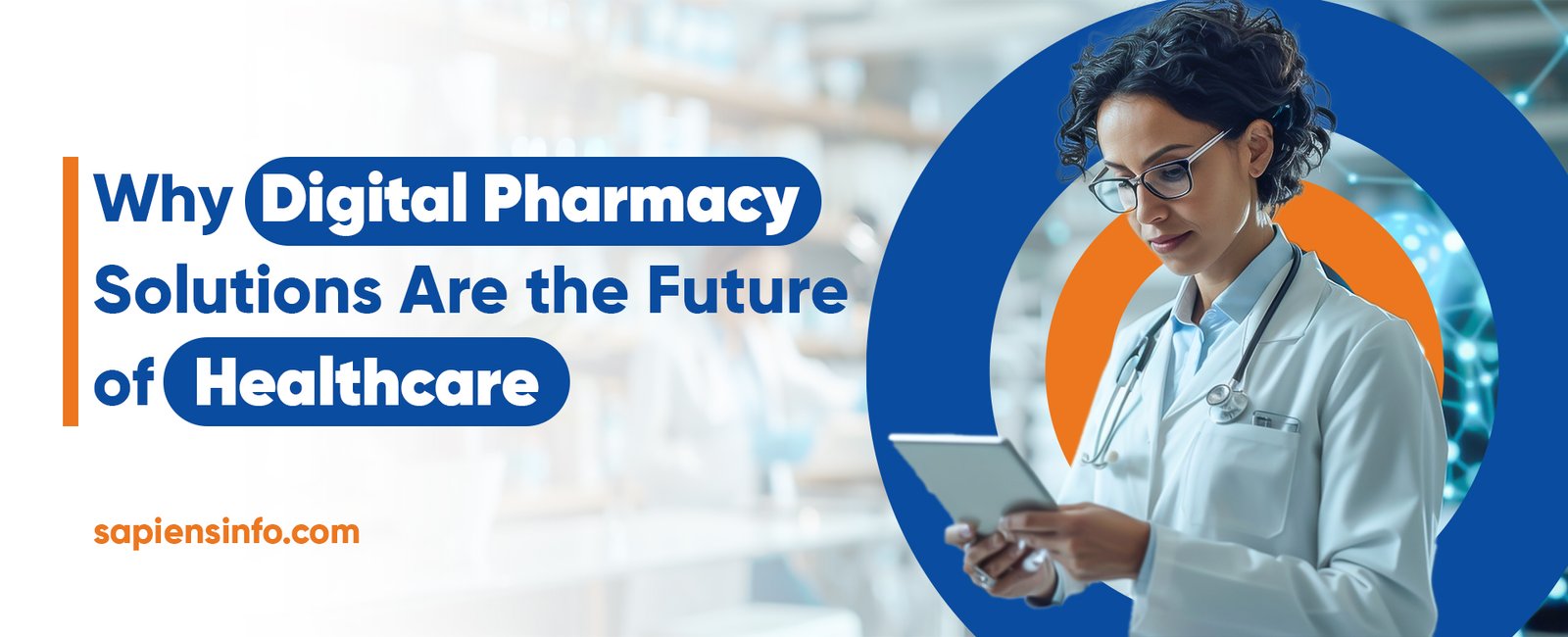Pharmacies are flooding with paperwork.
The list includes processing prescriptions, managing inventory, handling insurance claims, and more.
With these admin tasks at hand, pharmacy staff barely have time to breathe. But technology is changing everything.
Digital pharmacy solutions are transforming how pharmacies operate. These systems automate routine tasks, reduce errors, and free up pharmacists to focus on patient care.
This article explains all you need to know about why digital pharmacy solutions are the future of healthcare and how they can benefit both providers and patients.
What Are Digital Pharmacy Solutions?
Digital pharmacy solutions are comprehensive software systems that manage every aspect of pharmacy operations through integrated technology platforms.
Unlike basic prescription tracking software, modern pharmacy management systems connect all pharmacy functions into one unified platform.
This integration eliminates duplicate data entry and ensures information flows seamlessly between different processes.
Some of the core features include:
Prescription processing: Digital systems receive prescriptions electronically, automatically check for drug interactions and allergies, and flag potential issues before dispensing.
Inventory management: Real-time tracking of medication stock levels, automatic reorder alerts, expiration date monitoring, and supplier management all happen automatically.
Insurance and billing: Claims processing, insurance verification, and payment processing connect directly with insurance networks and payment systems.
Patient management: Comprehensive patient profiles include medication history, allergies, and communication records accessible to authorized staff instantly.
Reporting and analytics: Built-in dashboards track prescription volume, inventory turnover, revenue, and operational efficiency without manual compilation.
These features work together to create a pharmacy workflow optimization system that reduces manual work while improving accuracy and speed.
Benefits for Pharmacies
The advantages of implementing pharmacy software go far beyond just digitizing records.
These systems fundamentally improve how pharmacies operate.
Operational Efficiency
Manual prescription processing takes time. Pharmacists must read prescriptions, enter information into systems, check for interactions, and document everything.
Digital systems handle most of this automatically. Electronic prescriptions arrive pre-formatted, drug interaction checks happen instantly, and documentation generates automatically.
This efficiency means pharmacies can process more prescriptions with the same staff, reducing wait times and improving customer satisfaction.
Improved Accuracy and Safety
Human error in pharmacies can have serious consequences. Wrong medications, incorrect dosages, or missed drug interactions can harm patients.
A pharmacy management system catches these errors before they reach patients. Automated checks verify every prescription against the patient’s history, current medications, allergies, and potential drug interactions.
The system flags problems immediately, prompting pharmacists to review and resolve issues before dispensing.
Better Inventory Management
Pharmacies that run out of common medications frustrate customers and lose sales.
But overstocking ties up cash and risks medication expiration.
Digital inventory systems track usage patterns and predict demand. They automatically generate reorder suggestions based on actual usage and supplier lead times.
Expiration date tracking ensures older stock gets used first, reducing waste from expired medications.
Cost Savings
While pharmacy software requires upfront investment, the return comes quickly through multiple channels.
Automation reduces the time staff spend on administrative tasks, allowing pharmacies to handle higher volumes without proportional staff increases.
Also, automated insurance verification reduces rejection rates, improving cash flow and reducing administrative burden.
Impact on Patient Care
The real measure of pharmacy software benefits isn’t just internal efficiency – it’s the improvement in patient experience and outcomes.
Faster Prescription Processing
Patients expect speed. Digital systems dramatically reduce processing time.
Electronic prescriptions arrive instantly and begin processing automatically. Patients receive text notifications when prescriptions are ready, eliminating unnecessary calls.
For refills, automated systems can process routine requests without pharmacist intervention, freeing pharmacists to handle complex cases.
Fewer Medication Errors
Every prescription goes through automated checks before dispensing.
The system verifies the patient’s identity, checks for allergies and drug interactions, confirms appropriate dosages, and ensures the medication matches what the doctor prescribed.
Barcode scanning during dispensing ensures the right medication goes to the right patient, nearly eliminating mix-ups.
Improved Communication
Healthcare automation in pharmacies enables better patient engagement through automated refill reminders, prescription status updates, and secure messaging that allows patients to ask questions without phone calls.
This proactive communication helps patients stay on track with their medications and improves overall health outcomes.
Future Trends in Pharmacy Management
Digital pharmacy solutions continue growing rapidly.
Pharmacies adopting these technologies now are positioning themselves for future innovations:
i) Artificial Intelligence Integration
AI is making pharmacy systems smarter and more predictive.
Machine learning algorithms analyze prescription patterns to predict demand more accurately, optimize inventory levels, and identify potential medication therapy problems.
AI-powered chatbots handle routine patient questions about prescription status and refill requests, freeing staff for complex interactions.
ii) Cloud-Based Solutions
Cloud pharmacy systems eliminate the need for expensive on-premise servers and IT infrastructure.
Pharmacies can access their systems from anywhere, making remote work and multi-location management much easier.
Cloud solutions also enable easier integration with electronic health records, insurance networks, and other healthcare systems. Updates deploy automatically without pharmacy IT involvement.
iii) Advanced Data Analytics
Modern pharmacy management systems collect vast amounts of data about prescriptions, inventory, operations, and patient interactions. Advanced analytics turn this data into actionable insights.
Predictive analytics help pharmacies anticipate demand spikes, optimize staffing schedules, and identify revenue opportunities. Financial analytics provide detailed visibility into profitability by medication and insurance plan.
iv) Telepharmacy and Remote Services
Digital platforms enable pharmacies to extend their reach beyond physical locations.
Telepharmacy services allow pharmacists to consult with patients remotely and provide counseling through video calls.
Remote prescription verification enables one pharmacist to oversee multiple locations, improving efficiency without proportional staffing increases.
Conclusion
Independent and small chain pharmacies can’t compete on price alone. Success requires operational excellence, superior patient service, and the ability to provide value-added clinical services.
Digital pharmacy solutions provide the foundation for this competitive advantage.
Sapiens Info specializes in implementing such comprehensive digital pharmacy solutions that transform how pharmacies operate.
Book a call with us today to learn how our digital pharmacy solutions can improve your efficiency, reduce errors, and improve patient care.

